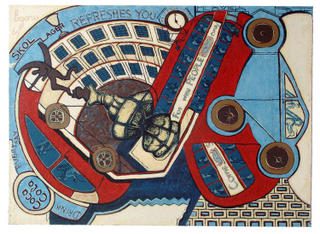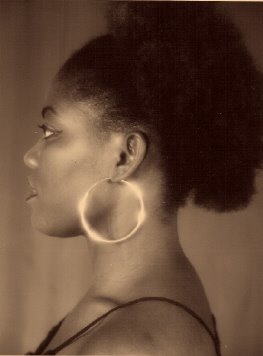Chasing Asiru Olatunde's Dreams

Chasing Asiru Olatunde’s Dreams
By Molara Wood
Crossing from the Ritz Hotel side of London’s Piccadilly into Albermarle Street, I arrive at the John Martin Gallery, venue of an exhibition of artworks by Asiru Olatunde, the old man of Osogbo Art.
I step into the sumptuous indigo space of the gallery, where walls are lined with ‘adire’ tie-and-dye fabrics. This is the background for copper and aluminium panels made by Olatunde, who died in 1992.
The Yoruba world rendered on the panels, though familiar, carries more than its fair share of mystery. It is my first time coming face to face with Asiru Olatunde’s pieces, and to have such a sizeable collection of his work on first viewing, is something of a blessing. Fortunately, the man who organised the exhibition, John Martin, is on hand to guide me through the works on display. Owner of two galleries and a specialist in British and Irish painting, Martin is an unlikely enthusiast for any kind of art from Africa, much less the works of a former blacksmith from Osogbo, the ancient Yoruba town on the Osun River.

Martin admits that this exhibition is something of a departure from his usual line; rather, it has come about purely because of his "private passion" for Asiru Olatunde’s art. The passion was sparked about five years ago, by his purchase of an artwork originally belonging to Ulli Beier. Much of Olatunde’s work went untitled by the artist himself, so that collectors have had to name many pieces. And so Martin’s first acquisition - three beaten aluminium panes joined up into a lyrical, rectangular whole - is now known as: ‘The Garden of Eden and the Expulsion From Paradise.’
Titles are therefore self-explanatory, and the Edenic trio shows God, the angels, Adam and Eve - all with African features. The clear mix of Christian religious symbols with elements of Yoruba mythology, for me, is crucial - and adds to the unexpectedness of the work. The snake tempting Eve with the apple, has a human head atop a long, riverine form. I inform Martin that this echoes the mythical snake thus described, in the classic, Igbo Olodumare, by D.O Fagunwa, the foremost novelist in the Yoruba language. It is Martin’s first time of hearing about Fagunwa, and he quickly notes down details of both author and book.
Martin has read Amos Tutuola’s The Palm-Wine Drinkard, however, and marvels at the free-flowing narrative. An excerpt from the novel, accompanies an image of a panel, ‘Palm Wine Drinkers’, in the exhibition catalogue. Palm-wine references are plentiful, in the profusion of images on many panels. Hunters are present, with their distinctive clothing and floppy caps; animals - known and unknown species - abound in lush forested scenes; as are birds and insects which sometimes resemble one another, to the point that the viewer can never tell an owl from a locust. To see Asiru Olatunde’s art, is to peep into the magically real world of the Yoruba.
All manners of creatures jostle with humans for every available aluminium repousse space, as part of a wondrous cascade in ‘Land of Plenty’. It is one of many pieces loaned to the show by an English collector who worked as an architect in Nigeria for many years. He suggested the displaying of works on adire background, and made fabrics available for John Martin’s use. More adire linings came from Iwalewa Haus, at the Centre for African Studies established by Ulli Beier, in the University of Bayreuth, Germany. Iwalewa Haus also loaned five substantial Olatunde artworks to the exhibition.
Now living in Australia, Beier helped plan the show, and wrote the introduction to the exhibition catalogue. He recounts meeting Olatunde for the first time, on moving to Osogbo in 1958. The late artist was one of the craftsmen in a blacksmith’s workshop opposite Beier’s house. "When an important man walked past… they would use their anvils like talking drums to recite his ‘oriki’ (praise names / poetry) and the person so honoured would reward them with a few coins." But Asiru Olatunde was in decline. Ill from heart disease, he could no longer do the strenuous work required of a blacksmith.
Things changed when, three years after their meeting, Ulli Beier found a beautifully crafted copper brooch in the sand outside his house. It had been made by Olatunde, then 42-years-old. And so began the art-life of the blacksmith who - Martin tell me - was slightly apart from the other artists in the Osogbo Movement, as he was older than them. With Beier’s encouragement, Olatunde started making copper earrings for sale - moving gradually to larger, pieces.
The exhibition spans the whole of the artist’s career, from the early beaten copper panels to the later, more expressive, aluminium ones. "He had these beautiful, natural sense of design," Martin says of Olatunde. My attention is drawn to the textured background to one copper repousse, Olatunde’s way of "filling the space," I’m told. Though not from a drumming family, the late artist played the talking drum every four days at the shrine of Obatala in Osogbo. ’The Temple of Obatala‘, a work made circa 1985, is on display. I see the logic in a sculpting artist feeling some devotion to Obatala, who the Yorubas believe, moulded the first human beings. And Martin observes that, perhaps because of Olatunde’s skill with the talking drum, "There is a kind of rhythm in all his work."
Though he was a Moslem, biblical stories were a recurrent theme in the work of Olatunde, who was regularly commissioned by churches. The acceptance of many religions is not anathema to the Yoruba, and this reflects in Olatunde’s work. Osogbo and its sacred river and goddess - seep strongly into the work. ‘The Osun River Festival’ (c.1969) - a large aluminium panel - has features that are instantly recognisable to anyone who has ever been to the Osun Grove, recently declared a World Heritage Site by UNESCO. Images of Osun shrine structures, including the ‘Aafin Akoko’ (the First Palace) are among the few dwelling-type shapes on the exhibited panels. I inform Martin that the annual Osun Festival (which takes place in the month of August) is virtually upon us.
Copper panels are warm and sensuous; aluminium ones catch the light and radiate the magic of departed and living worlds. John Martin has picked on the dreamlike quality of the images. Adding the metalwork term ‘chasing’, he came up with the exhibition title: ‘Asiru Olatunde - Chasing Dreams’.
The gallery owner now has many Asiru Olatunde pieces in his own private collection, but his first, showing the expulsion from paradise, remains special. "I live with it," Martin tells me, "every time I look at it, I see something new." He declares: "I’ll never part with it."
By the time I walk out of the gallery, I feel like I too, have been chasing dreams.
- Part of Africa 05, Asiru Olatunde: Chasing Dreams, was at the John Martin Gallery, London, from 30 June to 30 July.
Published in The Guardian, Lagos, 7 August 2005.



